stop start FIAT ULYSSE 2009 2.G Owners Manual
[x] Cancel search | Manufacturer: FIAT, Model Year: 2009, Model line: ULYSSE, Model: FIAT ULYSSE 2009 2.GPages: 254, PDF Size: 3.56 MB
Page 20 of 254
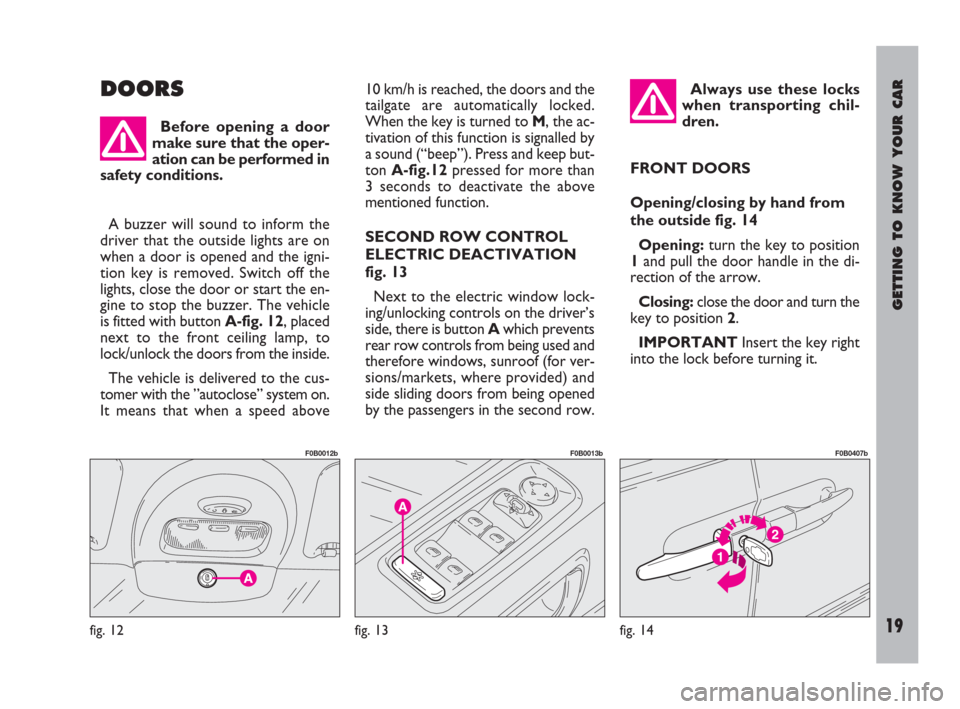
GETTING TO KNOW YOUR CAR
19
DOORS10 km/h is reached, the doors and the
tailgate are automatically locked.
When the key is turned to M, the ac-
tivation of this function is signalled by
a sound (“beep”). Press and keep but-
ton A-fig.12 pressed for more than
3 seconds to deactivate the above
mentioned function.
SECOND ROW CONTROL
ELECTRIC DEACTIVATION
fig. 13
Next to the electric window lock-
ing/unlocking controls on the driver’s
side, there is button Awhich prevents
rear row controls from being used and
therefore windows, sunroof (for ver-
sions/markets, where provided) and
side sliding doors from being opened
by the passengers in the second row.FRONT DOORS
Opening/closing by hand from
the outside fig. 14
Opening:turn the key to position
1and pull the door handle in the di-
rection of the arrow.
Closing:close the door and turn the
key to position 2.
IMPORTANT Insert the key right
into the lock before turning it.
fig. 12
F0B0012b
fig. 13
F0B0013b
fig. 14
F0B0407b
Always use these locks
when transporting chil-
dren.
Before opening a door
make sure that the oper-
ation can be performed in
safety conditions.
A buzzer will sound to inform the
driver that the outside lights are on
when a door is opened and the igni-
tion key is removed. Switch off the
lights, close the door or start the en-
gine to stop the buzzer. The vehicle
is fitted with button A-fig. 12, placed
next to the front ceiling lamp, to
lock/unlock the doors from the inside.
The vehicle is delivered to the cus-
tomer with the ”autoclose” system on.
It means that when a speed above
001-077 ULYSSE ING:001-077 ULYSSE ING 5-11-2009 12:11 Pagina 19
Page 23 of 254
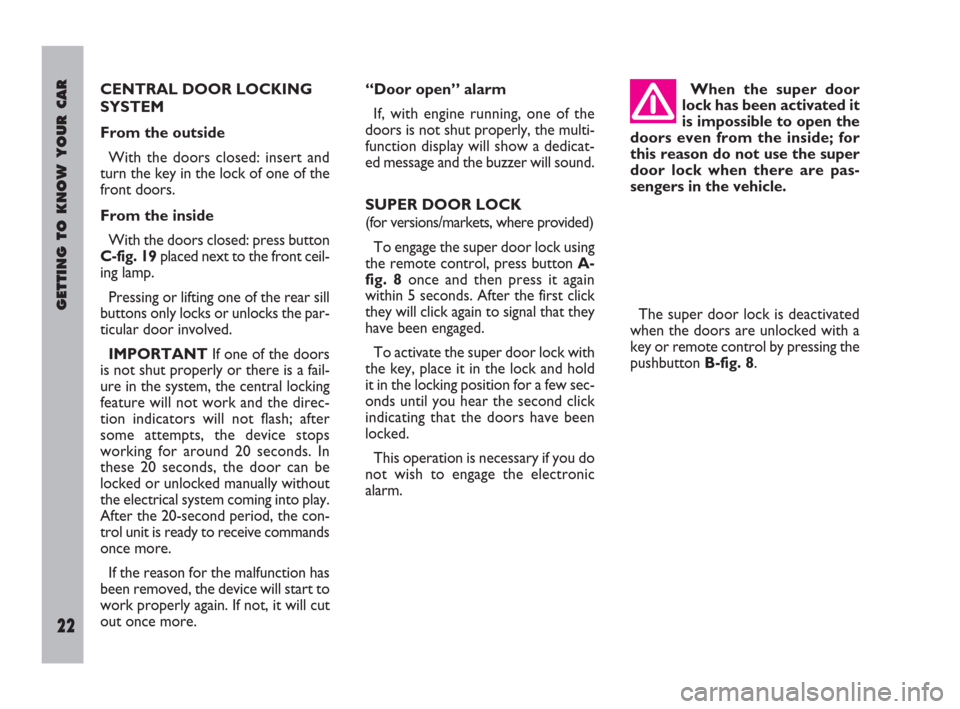
GETTING TO KNOW YOUR CAR
22
CENTRAL DOOR LOCKING
SYSTEM
From the outside
With the doors closed: insert and
turn the key in the lock of one of the
front doors.
From the inside
With the doors closed: press button
C-fig. 19placed next to the front ceil-
ing lamp.
Pressing or lifting one of the rear sill
buttons only locks or unlocks the par-
ticular door involved.
IMPORTANTIf one of the doors
is not shut properly or there is a fail-
ure in the system, the central locking
feature will not work and the direc-
tion indicators will not flash; after
some attempts, the device stops
working for around 20 seconds. In
these 20 seconds, the door can be
locked or unlocked manually without
the electrical system coming into play.
After the 20-second period, the con-
trol unit is ready to receive commands
once more.
If the reason for the malfunction has
been removed, the device will start to
work properly again. If not, it will cut
out once more.“Door open” alarm
If, with engine running, one of the
doors is not shut properly, the multi-
function display will show a dedicat-
ed message and the buzzer will sound.
SUPER DOOR LOCK
(for versions/markets, where provided)
To engage the super door lock using
the remote control, press button A-
fig. 8once and then press it again
within 5 seconds. After the first click
they will click again to signal that they
have been engaged.
To activate the super door lock with
the key, place it in the lock and hold
it in the locking position for a few sec-
onds until you hear the second click
indicating that the doors have been
locked.
This operation is necessary if you do
not wish to engage the electronic
alarm.When the super door
lock has been activated it
is impossible to open the
doors even from the inside; for
this reason do not use the super
door lock when there are pas-
sengers in the vehicle.
The super door lock is deactivated
when the doors are unlocked with a
key or remote control by pressing the
pushbutton B-fig. 8.
001-077 ULYSSE ING:001-077 ULYSSE ING 5-11-2009 12:11 Pagina 22
Page 53 of 254
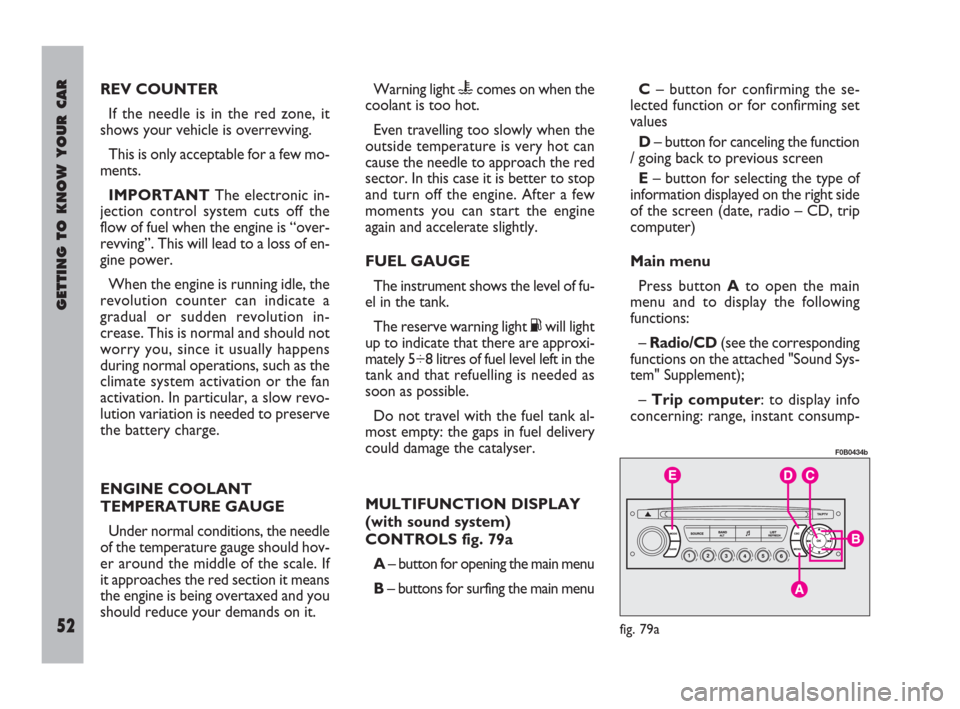
GETTING TO KNOW YOUR CAR
52
Warning light ucomes on when the
coolant is too hot.
Even travelling too slowly when the
outside temperature is very hot can
cause the needle to approach the red
sector. In this case it is better to stop
and turn off the engine. After a few
moments you can start the engine
again and accelerate slightly.
FUEL GAUGE
The instrument shows the level of fu-
el in the tank.
The reserve warning light Kwill light
up to indicate that there are approxi-
mately 5÷8 litres of fuel level left in the
tank and that refuelling is needed as
soon as possible.
Do not travel with the fuel tank al-
most empty: the gaps in fuel delivery
could damage the catalyser.
MULTIFUNCTION DISPLAY
(with sound system)
CONTROLS fig. 79a
A– button for opening the main menu
B– buttons for surfing the main menu REV COUNTER
If the needle is in the red zone, it
shows your vehicle is overrevving.
This is only acceptable for a few mo-
ments.
IMPORTANTThe electronic in-
jection control system cuts off the
flow of fuel when the engine is “over-
revving”. This will lead to a loss of en-
gine power.
When the engine is running idle, the
revolution counter can indicate a
gradual or sudden revolution in-
crease. This is normal and should not
worry you, since it usually happens
during normal operations, such as the
climate system activation or the fan
activation. In particular, a slow revo-
lution variation is needed to preserve
the battery charge.
ENGINE COOLANT
TEMPERATURE GAUGE
Under normal conditions, the needle
of the temperature gauge should hov-
er around the middle of the scale. If
it approaches the red section it means
the engine is being overtaxed and you
should reduce your demands on it.C– button for confirming the se-
lected function or for confirming set
values
D– button for canceling the function
/ going back to previous screen
E– button for selecting the type of
information displayed on the right side
of the screen (date, radio – CD, trip
computer)
Main menu
Press button Ato open the main
menu and to display the following
functions:
– Radio/CD(see the corresponding
functions on the attached "Sound Sys-
tem" Supplement);
– Trip computer: to display info
concerning: range, instant consump-
fig. 79a
F0B0434b
001-077 ULYSSE ING:001-077 ULYSSE ING 5-11-2009 12:11 Pagina 52
Page 59 of 254
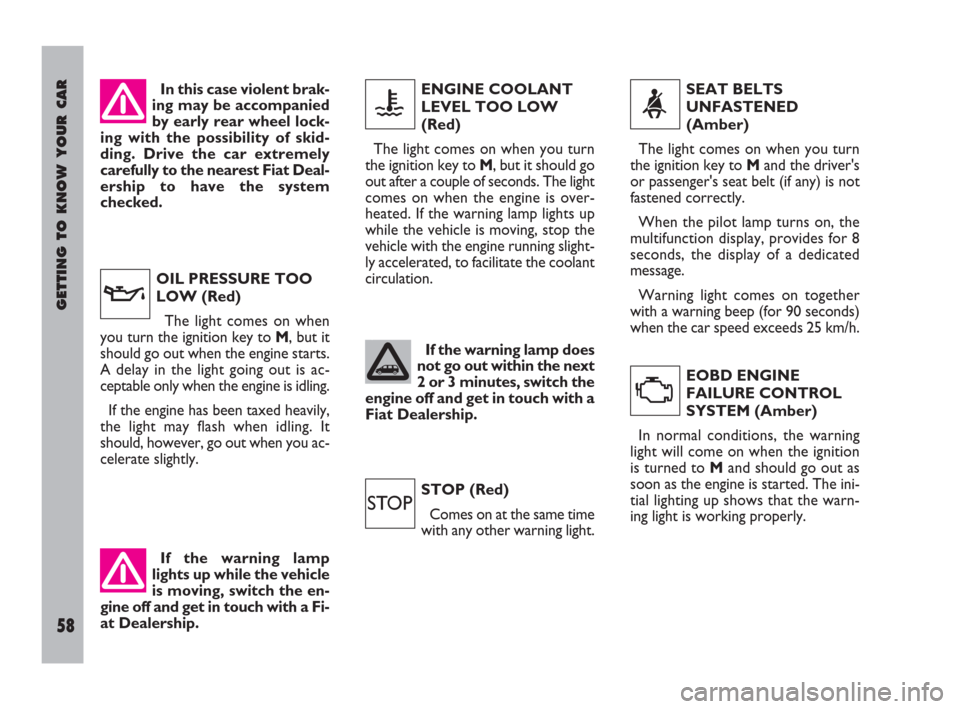
GETTING TO KNOW YOUR CAR
58
ENGINE COOLANT
LEVEL TOO LOW
(Red)
The light comes on when you turn
the ignition key to M, but it should go
out after a couple of seconds. The light
comes on when the engine is over-
heated. If the warning lamp lights up
while the vehicle is moving, stop the
vehicle with the engine running slight-
ly accelerated, to facilitate the coolant
circulation.
STOP (Red)
Comes on at the same time
with any other warning light.SEAT BELTS
UNFASTENED
(Amber)
The light comes on when you turn
the ignition key to Mand the driver's
or passenger's seat belt (if any) is not
fastened correctly.
When the pilot lamp turns on, the
multifunction display, provides for 8
seconds, the display of a dedicated
message.
Warning light comes on together
with a warning beep (for 90 seconds)
when the car speed exceeds 25 km/h.
EOBD ENGINE
FAILURE CONTROL
SYSTEM (Amber)
In normal conditions, the warning
light will come on when the ignition
is turned to M and should go out as
soon as the engine is started. The ini-
tial lighting up shows that the warn-
ing light is working properly.
u
ì
<
U
If the warning lamp does
not go out within the next
2 or 3 minutes, switch the
engine off and get in touch with a
Fiat Dealership.
OIL PRESSURE TOO
LOW (Red)
The light comes on when
you turn the ignition key to M, but it
should go out when the engine starts.
A delay in the light going out is ac-
ceptable only when the engine is idling.
If the engine has been taxed heavily,
the light may flash when idling. It
should, however, go out when you ac-
celerate slightly.
v
In this case violent brak-
ing may be accompanied
by early rear wheel lock-
ing with the possibility of skid-
ding. Drive the car extremely
carefully to the nearest Fiat Deal-
ership to have the system
checked.
If the warning lamp
lights up while the vehicle
is moving, switch the en-
gine off and get in touch with a Fi-
at Dealership.
001-077 ULYSSE ING:001-077 ULYSSE ING 5-11-2009 12:11 Pagina 58
Page 60 of 254
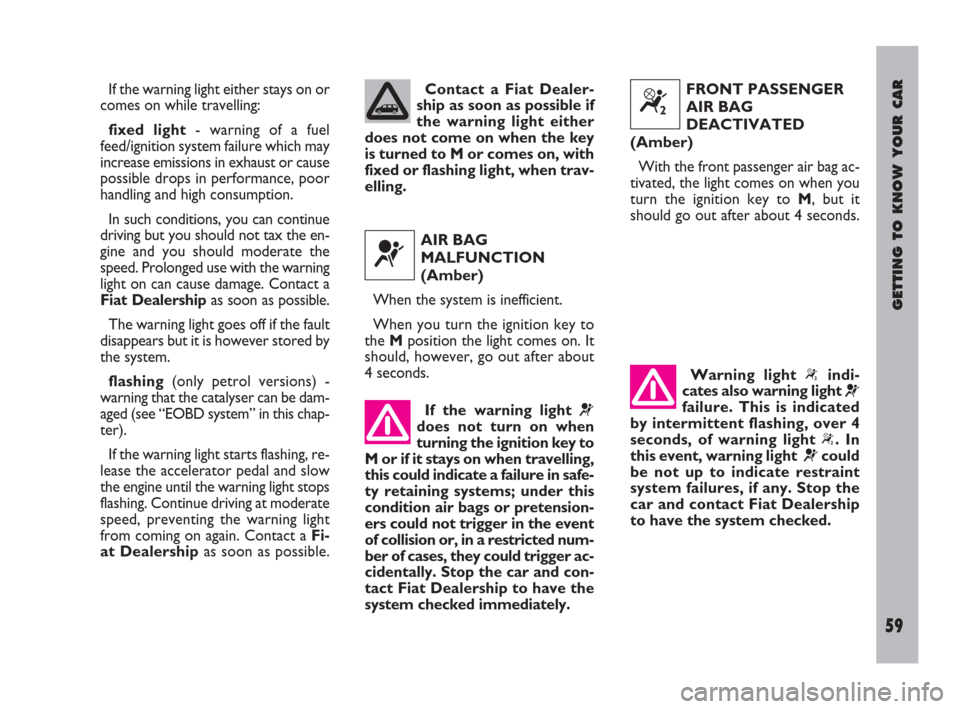
GETTING TO KNOW YOUR CAR
59
If the warning light either stays on or
comes on while travelling:
fixed light- warning of a fuel
feed/ignition system failure which may
increase emissions in exhaust or cause
possible drops in performance, poor
handling and high consumption.
In such conditions, you can continue
driving but you should not tax the en-
gine and you should moderate the
speed. Prolonged use with the warning
light on can cause damage. Contact a
Fiat Dealershipas soon as possible.
The warning light goes off if the fault
disappears but it is however stored by
the system.
flashing(only petrol versions) -
warning that the catalyser can be dam-
aged (see “EOBD system” in this chap-
ter).
If the warning light starts flashing, re-
lease the accelerator pedal and slow
the engine until the warning light stops
flashing. Continue driving at moderate
speed, preventing the warning light
from coming on again. Contact a Fi-
at Dealershipas soon as possible. AIR BAG
MALFUNCTION
(Amber)
When the system is inefficient.
When you turn the ignition key to
the Mposition the light comes on. It
should, however, go out after about
4 seconds.
¬
Contact a Fiat Dealer-
ship as soon as possible if
the warning light either
does not come on when the key
is turned to M or comes on, with
fixed or flashing light, when trav-
elling.
If the warning light ¬
does not turn on when
turning the ignition key to
M or if it stays on when travelling,
this could indicate a failure in safe-
ty retaining systems; under this
condition air bags or pretension-
ers could not trigger in the event
of collision or, in a restricted num-
ber of cases, they could trigger ac-
cidentally. Stop the car and con-
tact Fiat Dealership to have the
system checked immediately.
FRONT PASSENGER
AIR BAG
DEACTIVATED
(Amber)
With the front passenger air bag ac-
tivated, the light comes on when you
turn the ignition key to M, but it
should go out after about 4 seconds.
Warning light
“indi-
cates also warning light
¬
failure. This is indicated
by intermittent flashing, over 4
seconds, of warning light
“. In
this event, warning light
¬could
be not up to indicate restraint
system failures, if any. Stop the
car and contact Fiat Dealership
to have the system checked.
“
001-077 ULYSSE ING:001-077 ULYSSE ING 5-11-2009 12:11 Pagina 59
Page 62 of 254
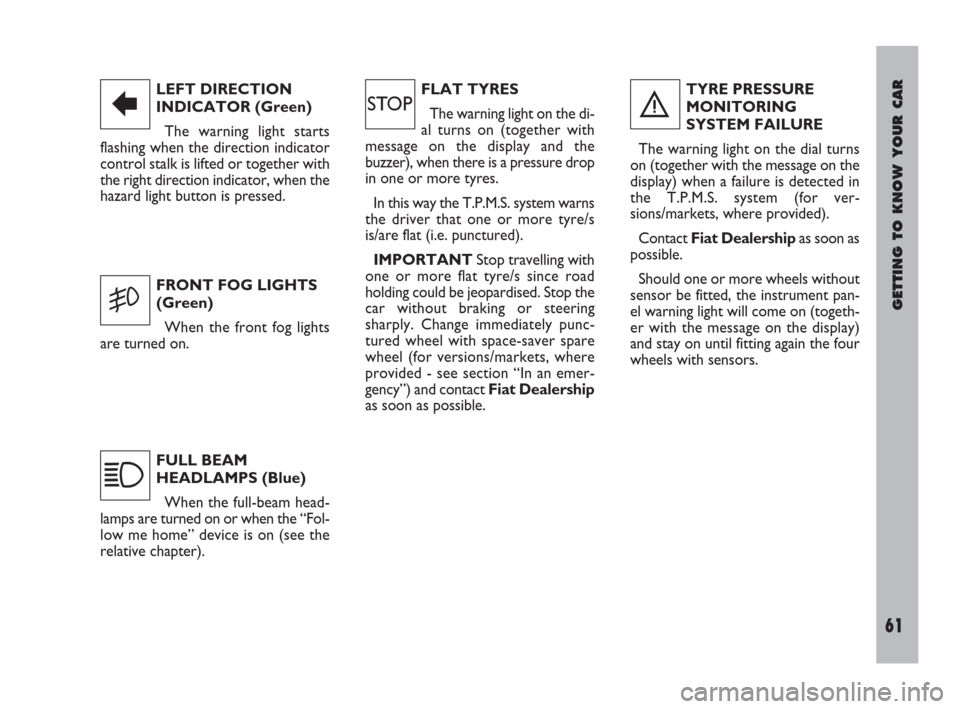
GETTING TO KNOW YOUR CAR
61
LEFT DIRECTION
INDICATOR (Green)
The warning light starts
flashing when the direction indicator
control stalk is lifted or together with
the right direction indicator, when the
hazard light button is pressed.
FRONT FOG LIGHTS
(Green)
When the front fog lights
are turned on.
FULL BEAM
HEADLAMPS (Blue)
When the full-beam head-
lamps are turned on or when the “Fol-
low me home” device is on (see the
relative chapter).
R
5
1
FLAT TYRES
The warning light on the di-
al turns on (together with
message on the display and the
buzzer), when there is a pressure drop
in one or more tyres.
In this way the T.P.M.S. system warns
the driver that one or more tyre/s
is/are flat (i.e. punctured).
IMPORTANTStop travelling with
one or more flat tyre/s since road
holding could be jeopardised. Stop the
car without braking or steering
sharply. Change immediately punc-
tured wheel with space-saver spare
wheel (for versions/markets, where
provided - see section “In an emer-
gency”) and contact Fiat Dealership
as soon as possible.TYRE PRESSURE
MONITORING
SYSTEM FAILURE
The warning light on the dial turns
on (together with the message on the
display) when a failure is detected in
the T.P.M.S. system (for ver-
sions/markets, where provided).
Contact Fiat Dealershipas soon as
possible.
Should one or more wheels without
sensor be fitted, the instrument pan-
el warning light will come on (togeth-
er with the message on the display)
and stay on until fitting again the four
wheels with sensors.
ìè
001-077 ULYSSE ING:001-077 ULYSSE ING 5-11-2009 12:11 Pagina 61
Page 97 of 254
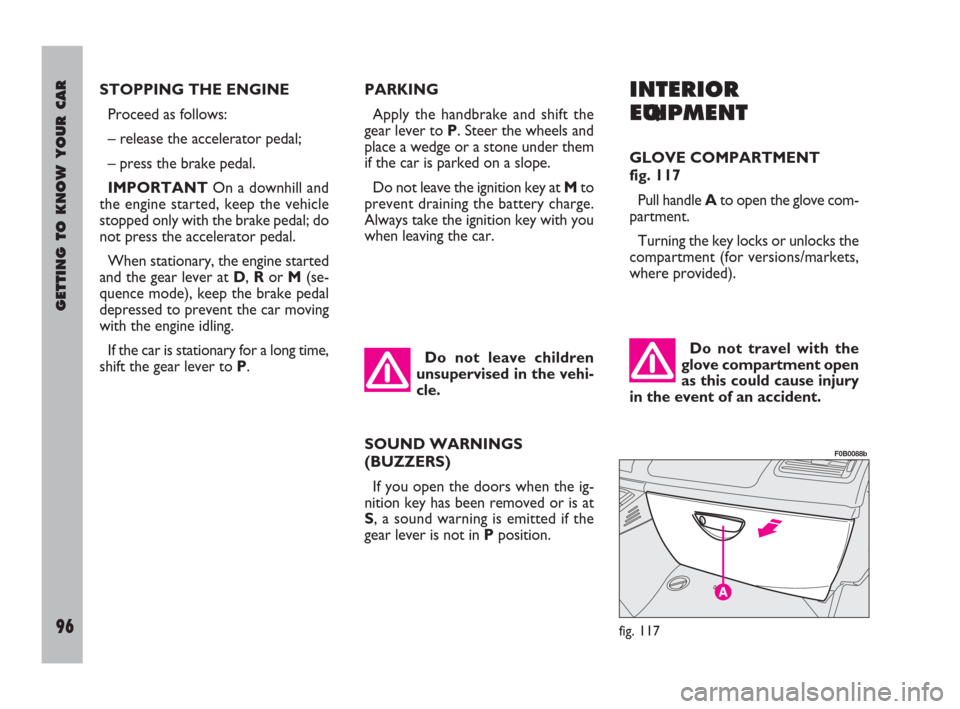
GETTING TO KNOW YOUR CAR
96
INTERIOR
EQUIPMENT
GLOVE COMPARTMENT
fig. 117
Pull handle Ato open the glove com-
partment.
Turning the key locks or unlocks the
compartment (for versions/markets,
where provided).
Do not travel with the
glove compartment open
as this could cause injury
in the event of an accident.
fig. 117
F0B0088b
STOPPING THE ENGINE
Proceed as follows:
– release the accelerator pedal;
– press the brake pedal.
IMPORTANTOn a downhill and
the engine started, keep the vehicle
stopped only with the brake pedal; do
not press the accelerator pedal.
When stationary, the engine started
and the gear lever at D, Ror M(se-
quence mode), keep the brake pedal
depressed to prevent the car moving
with the engine idling.
If the car is stationary for a long time,
shift the gear lever to P.PARKING
Apply the handbrake and shift the
gear lever to P. Steer the wheels and
place a wedge or a stone under them
if the car is parked on a slope.
Do not leave the ignition key at Mto
prevent draining the battery charge.
Always take the ignition key with you
when leaving the car.
SOUND WARNINGS
(BUZZERS)
If you open the doors when the ig-
nition key has been removed or is at
S, a sound warning is emitted if the
gear lever is not in Pposition. Do not leave children
unsupervised in the vehi-
cle.
078-135 ULYSSE ING 10-03-2009 11:39 Pagina 96
Page 106 of 254
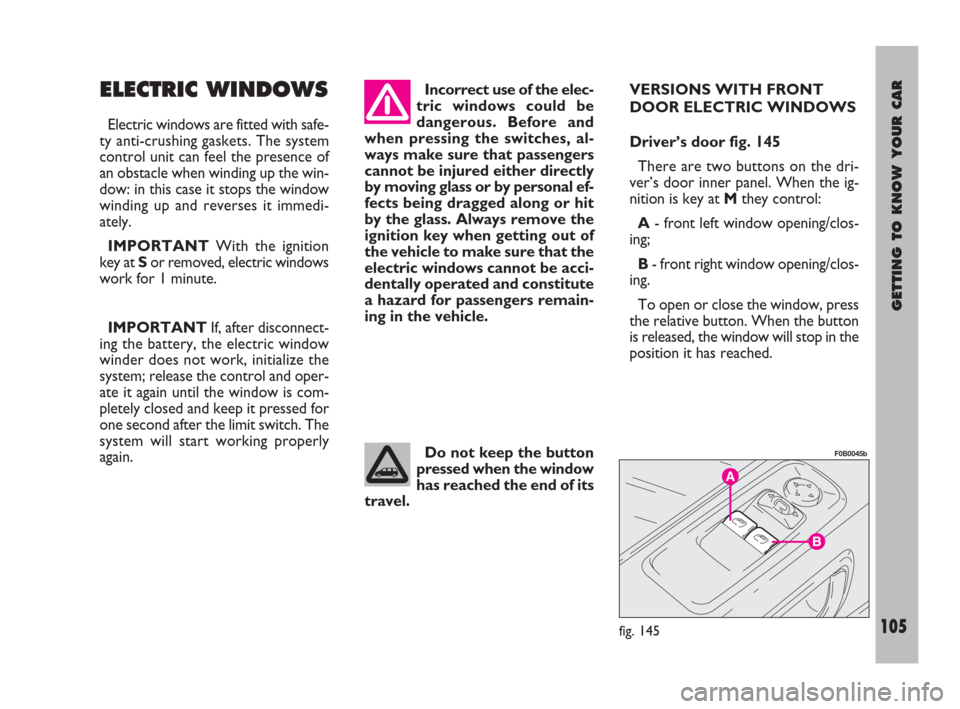
GETTING TO KNOW YOUR CAR
105
ELECTRIC WINDOWS
Electric windows are fitted with safe-
ty anti-crushing gaskets. The system
control unit can feel the presence of
an obstacle when winding up the win-
dow: in this case it stops the window
winding up and reverses it immedi-
ately.
IMPORTANTWith the ignition
key at Sor removed, electric windows
work for 1 minute.
IMPORTANTIf, after disconnect-
ing the battery, the electric window
winder does not work, initialize the
system; release the control and oper-
ate it again until the window is com-
pletely closed and keep it pressed for
one second after the limit switch. The
system will start working properly
again.Incorrect use of the elec-
tric windows could be
dangerous. Before and
when pressing the switches, al-
ways make sure that passengers
cannot be injured either directly
by moving glass or by personal ef-
fects being dragged along or hit
by the glass. Always remove the
ignition key when getting out of
the vehicle to make sure that the
electric windows cannot be acci-
dentally operated and constitute
a hazard for passengers remain-
ing in the vehicle.VERSIONS WITH FRONT
DOOR ELECTRIC WINDOWS
Driver’s door fig. 145
There are two buttons on the dri-
ver’s door inner panel. When the ig-
nition is key at M they control:
A- front left window opening/clos-
ing;
B- front right window opening/clos-
ing.
To open or close the window, press
the relative button. When the button
is released, the window will stop in the
position it has reached.
Do not keep the button
pressed when the window
has reached the end of its
travel.
fig. 145
F0B0045b
078-135 ULYSSE ING 10-03-2009 11:39 Pagina 105
Page 107 of 254
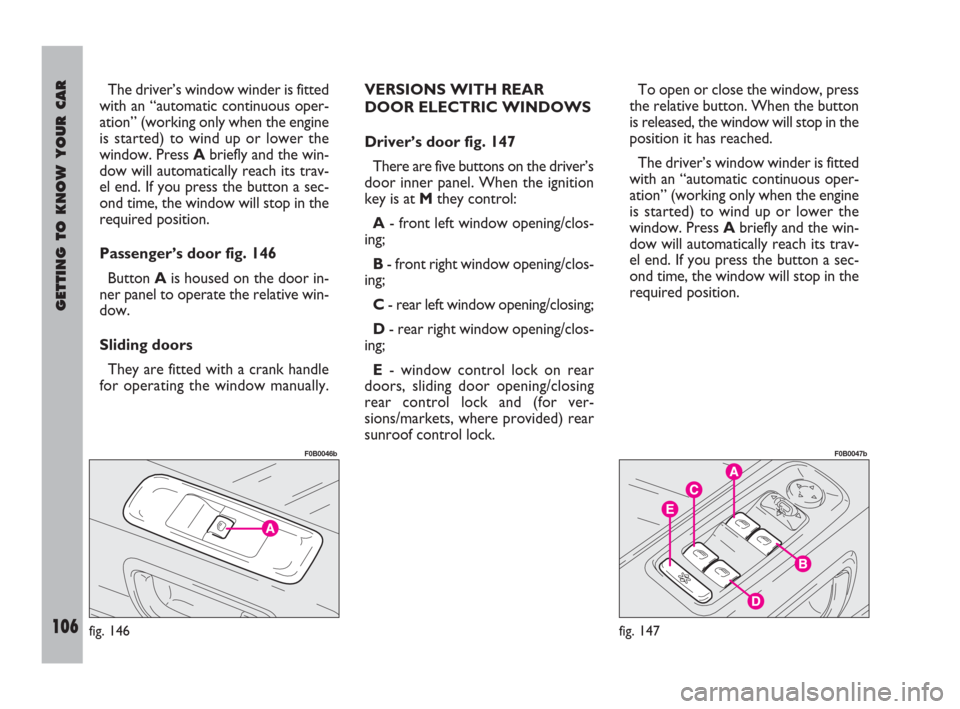
GETTING TO KNOW YOUR CAR
106
The driver’s window winder is fitted
with an “automatic continuous oper-
ation” (working only when the engine
is started) to wind up or lower the
window. Press Abriefly and the win-
dow will automatically reach its trav-
el end. If you press the button a sec-
ond time, the window will stop in the
required position.
Passenger’s door fig. 146
Button Ais housed on the door in-
ner panel to operate the relative win-
dow.
Sliding doors
They are fitted with a crank handle
for operating the window manually.VERSIONS WITH REAR
DOOR ELECTRIC WINDOWS
Driver’s door fig. 147
There are five buttons on the driver’s
door inner panel. When the ignition
key is at Mthey control:
A- front left window opening/clos-
ing;
B- front right window opening/clos-
ing;
C- rear left window opening/closing;
D- rear right window opening/clos-
ing;
E- window control lock on rear
doors, sliding door opening/closing
rear control lock and (for ver-
sions/markets, where provided) rear
sunroof control lock.To open or close the window, press
the relative button. When the button
is released, the window will stop in the
position it has reached.
The driver’s window winder is fitted
with an “automatic continuous oper-
ation” (working only when the engine
is started) to wind up or lower the
window. Press Abriefly and the win-
dow will automatically reach its trav-
el end. If you press the button a sec-
ond time, the window will stop in the
required position.
fig. 146
F0B0046b
fig. 147
F0B0047b
078-135 ULYSSE ING 10-03-2009 11:39 Pagina 106
Page 114 of 254
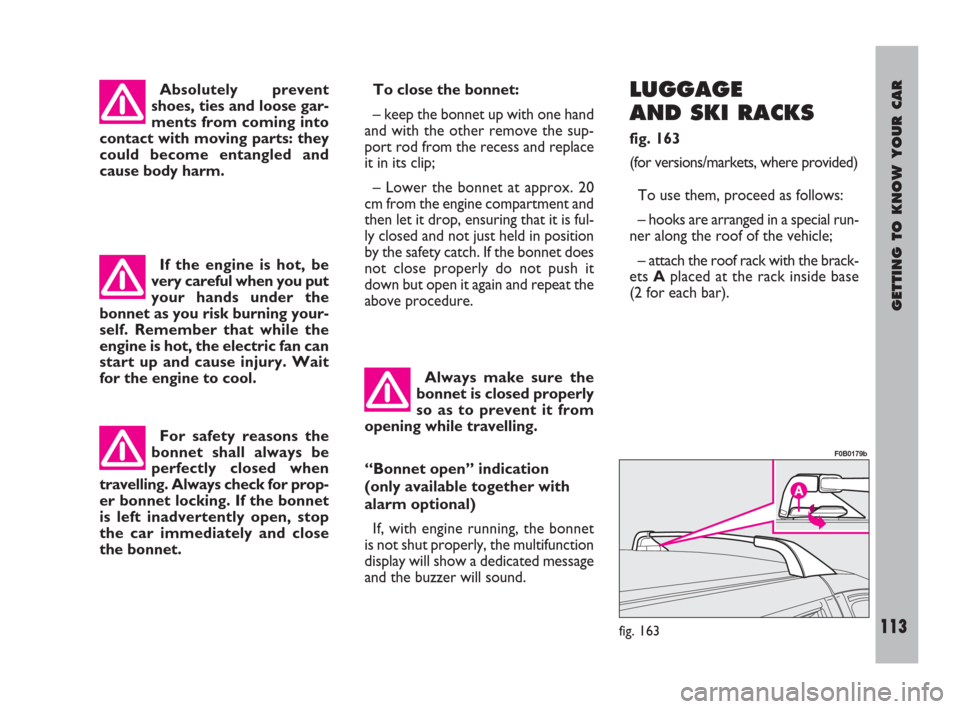
GETTING TO KNOW YOUR CAR
113
To close the bonnet:
– keep the bonnet up with one hand
and with the other remove the sup-
port rod from the recess and replace
it in its clip;
– Lower the bonnet at approx. 20
cm from the engine compartment and
then let it drop, ensuring that it is ful-
ly closed and not just held in position
by the safety catch. If the bonnet does
not close properly do not push it
down but open it again and repeat the
above procedure.LUGGAGE
AND SKI RACKS
fig. 163
(for versions/markets, where provided)
To use them, proceed as follows:
– hooks are arranged in a special run-
ner along the roof of the vehicle;
– attach the roof rack with the brack-
ets Aplaced at the rack inside base
(2 for each bar). Absolutely prevent
shoes, ties and loose gar-
ments from coming into
contact with moving parts: they
could become entangled and
cause body harm.
If the engine is hot, be
very careful when you put
your hands under the
bonnet as you risk burning your-
self. Remember that while the
engine is hot, the electric fan can
start up and cause injury. Wait
for the engine to cool.
For safety reasons the
bonnet shall always be
perfectly closed when
travelling. Always check for prop-
er bonnet locking. If the bonnet
is left inadvertently open, stop
the car immediately and close
the bonnet.Always make sure the
bonnet is closed properly
so as to prevent it from
opening while travelling.
“Bonnet open” indication
(only available together with
alarm optional)
If, with engine running, the bonnet
is not shut properly, the multifunction
display will show a dedicated message
and the buzzer will sound.
fig. 163
F0B0179b
078-135 ULYSSE ING 10-03-2009 11:39 Pagina 113